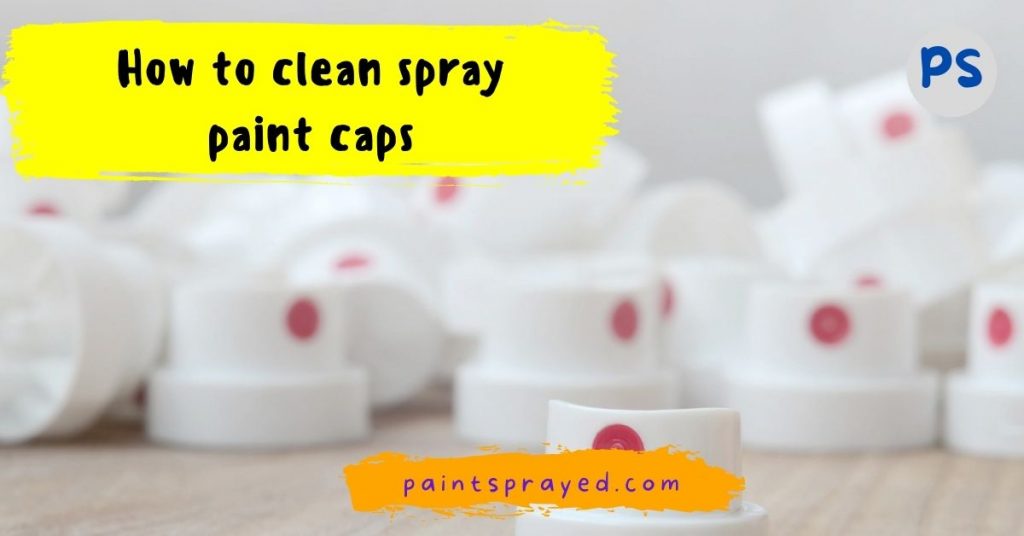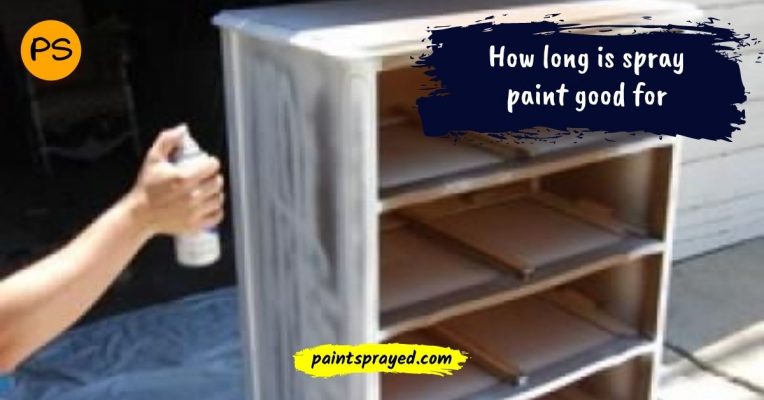In this post, I have explained each step regarding the cleaning of the spray can cap with some methods which I often use for myself whenever the spray paint can make issues.
This post which I have written solely based on my own experience got from plenty of years should be considered.
So, newbies are requested not to try anything else by themselves, or else they might mess up their spray cans and then later regret their actions will disappoint them.
Newcomers should follow each step explained in this guide in order to achieve the best results.
There are a variety of ways that you can clean your spray paint caps, and many of them are pretty similar.
However, it’s important to remember that there are many different brands and types of spray paint on the market.
You may have to make some modifications to these methods, but these simple steps can give you an idea of how to effectively clean your spray paint caps.
How to clean spray paint caps?
Method to clean spray paint cap with paint thinner
There are multiple ways to clean a paint sprayer quickly, but the most common and effective way is soaking the cap in paint thinner.
Here are the steps: First of all, the cleaner has to be sure that the paint sprayer is turned off. Protection goggles should be worn as paint thinner is a dangerous chemical.
After putting on your goggles, you should turn the sprayer upside down and let the paint thinner run through the tube.
To make a point, it is better to turn the sprayer on its side and pour paint thinner into the air hole.
Wear nitrile gloves in case of any spillage. The gun may have to be turned upside down and sideways for better results.
This should be done for about 5 minutes. If it doesn’t work, follow the cleaning process again.
After cleaning, make sure that the spray gun is completely dry before using it. If there is no paint thinner available, or it can’t be used, then run the sprayer with just water to clean it.
Note that this is not as quick or effective as using the right kind of solvent, but it will work.
Use a Safety pin to clean spray can caps
Spray paint caps are a pain in the**. They sometimes pop off unexpectedly, either in your pocket or in a car at a bad time.
Cleaning spray paint caps is sometimes a chore as well, as you have to make sure not to damage the cap, or both the cap can leak or lose their color.

I have found that a safety pin works best to poke tiny holes in the spray paint cap with little effort.
You can use a sewing needle, but the safety pin is significantly easier to use and less likely to damage the cap.
Just poke a few holes in the cap, and the cap will be less likely to pop off the next time you use it.
Method to clean spray caps with WD-40
Spray paint is a tried and true method for making art. This type of paint leaves a solid layer of paint on the walls and ceilings of any area you spray it on.
So you can use the results of your efforts for a long time to come.
If you don’t clean up the spray paint can’s cap afterward, though, the paint can dry and harden, making it impossible to use again in the future.
Use WD-40 to clean spray paint caps. Simply spray the cap down, wait a few seconds and wipe it off with a paper towel.
This should work to remove the hardened paint and enable your spray paint can be used again.
Tips to Prevent future clogging
To avoid clogs in the future, take a moment to wipe your cap clean with some expendable cloths.
After every so many use and ensure that you’re holding your can upside down when spraying.
Feel free to open up a pin in the center by inserting it into the top before you start storing it as well.
This will play an important role in keeping your spray paint from clogging up.
Can you use acetone to clean spray paint caps?
Yes, acetone can be used to clean spray paint caps. Acetone is a strong solvent that can dissolve dried paint and other contaminants, making it an effective cleaner for spray paint caps.
To clean a spray paint cap using acetone, you will need to first remove the cap from the spray paint can.
Next, pour a small amount of acetone into a container and immerse the cap in the solvent.
You may need to use a brush or cloth to scrub the cap to remove any dried paint or other contaminants.
Once the cap is clean, rinse it with water and dry it thoroughly before reattaching it to the spray paint can.
It’s important to note that acetone is a flammable solvent and should be used with caution.
Be sure to follow proper safety precautions when using acetone, such as working in a well-ventilated area and keeping the solvent away from open flames or heat sources.
How do you keep graffiti caps clean?
There are a few steps you can take to keep graffiti caps clean and in good working condition:
- Clean the cap after each use: After each use, rinse the cap with water and scrub it with a soft brush to remove any dried paint or other contaminants.
- Store the cap properly: When not in use, store the cap in a clean, dry place away from direct sunlight and heat sources. This will help prevent the cap from drying out or becoming clogged with contaminants.
- Use a cap cleaner: Cap cleaners are specially designed products that can help remove dried paint and other contaminants from graffiti caps. Simply soak the cap in the cleaner for a few minutes, then rinse and dry it thoroughly before reattaching it to the spray paint can.
- Replace the cap if it becomes damaged or too dirty: If the cap becomes damaged or is no longer able to produce a clean, even spray pattern, it’s time to replace it.
By following these steps, you can help ensure that your graffiti caps are always ready for use and produce the best possible results.
Can I reuse spray caps?
It is generally possible to reuse spray paint caps, as long as they are clean and in good working condition.
However, there are a few factors to consider when deciding whether or not to reuse a spray cap:
- Condition of the cap: If the cap is damaged or no longer produces a clean, even spray pattern, it may be best to replace it rather than trying to reuse it.
- Type of paint: Some types of paint, such as oil-based paints or certain specialty paints, can be more difficult to clean from spray caps and may not be suitable for reuse.
- Age of the cap: Over time, spray caps can become clogged or dried out, making them less effective. If the cap has been stored for a long period of time or has been used frequently, it may be best to replace it.
In general, it is a good idea to clean and dry spray caps thoroughly after each use to help ensure that they remain in good working condition and are ready for reuse.
If you are unsure whether a particular cap is still usable, it may be best to replace it to ensure the best possible results.
Will rubbing alcohol remove spray paint from plastic?
Yes, rubbing alcohol (also known as isopropyl alcohol) can be effective at removing spray paint from plastic surfaces.
Rubbing alcohol is a strong solvent that can dissolve many types of paint, making it a useful tool for removing spray paint from plastic and other surfaces.
To remove spray paint from plastic using rubbing alcohol, follow these steps:
- Protect surrounding areas: Cover any areas that you don’t want to get sprayed with plastic or a drop cloth.
- Apply rubbing alcohol: Using a cloth or sponge, apply a generous amount of rubbing alcohol to the area with the spray paint.
- Scrub the surface: Scrub the area with a scrub brush or abrasive sponge to loosen and remove the paint.
- Wipe away the paint: Wipe away the paint and rubbing alcohol with a clean cloth. If any paint remains, repeat steps 2-4 until the surface is clean.
- Rinse the surface: Once all of the paint has been removed, rinse the surface with water and dry it thoroughly.
It’s important to note that rubbing alcohol can damage some types of plastic, so it’s a good idea to test the alcohol on a small, inconspicuous area before using it on a larger surface.
How do you clean spray paint tops?
To clean spray paint cans, you can use solvents such as acetone or mineral spirits to dissolve and remove the paint residue.
Another option is to use an abrasive material such as sandpaper or a wire brush to scrub the residue off.
It’s important to wear gloves and work in a well-ventilated area when using solvents.
How do you clear a clogged spray paint nozzle?
To clear a clogged spray paint nozzle, you can follow these steps:
- Remove the nozzle: Turn the can upside down and gently twist the nozzle to remove it from the can.
- Clean the nozzle: Soak the nozzle in a solvent such as acetone or mineral spirits for several minutes to dissolve the paint residue. Alternatively, you can use a needle or wire to clear the clog.
- Dry the nozzle: Use a clean cloth to dry the nozzle thoroughly before reattaching it to the can.
- Reattach the nozzle: Make sure the nozzle is securely reattached to the can before using it. If the nozzle still doesn’t work properly, try repeating the steps or replacing the nozzle.
It’s important to wear gloves and work in a well-ventilated area when using solvents.
FAQ’s of How to clean spray paint caps
Conclusion on How to clean spray paint caps
This is it, guys! The complete guide on how to clean spray paint caps is in this post of mine which is based on my experience of past painting years.
Newbies should first use the easy methods if they are afraid to apply the other methods to their spray paint caps.
You are now prepared to use spray paint to decorate, or even repair, your favorite piece of furniture. Follow the tips in this post to keep your spray-painting experience safe and fun.

Matthew Edward is a professional painter who loves to paint and wants to share useful tips and tricks which he had learned in many years of experience in painting. He also used many products that can be used for painting he has tried and tested each and every product to give an unbias opinion about it in his review. This blog is very useful for those newbies who want to learn painting without making mistakes.






